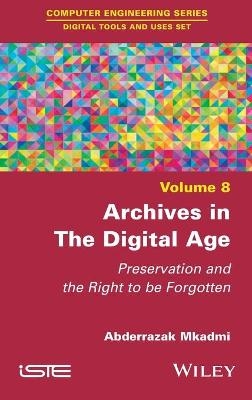
Archives in the Digital Age
ISTE Ltd and John Wiley & Sons Inc (Verlag)
978-1-78630-676-0 (ISBN)
Archives in The Digital Age focuses on the impact of these various digital transformations on archives, and examines how the right to memory and the information of future generations is confronted with the right to be forgotten; a digital prerogative that guarantees individuals their private lives and freedoms.
Abderrazak Mkadmi holds a PhD in Information and Communication Sciences from the University of Paris 8, France, and is a Research Professor at the Higher Institute of Documentation (Manouba University, Tunisia).
Preface ix
Introduction xi
Chapter 1. Digital Archives: Elements of Definition 1
1.1. Key concepts of digital archives 1
1.1.1. Archives 1
1.1.2. Archive management 2
1.1.3. Archival management tools 4
1.1.4. Digital archives 7
1.2. Electronic Records Management 7
1.2.1. ERM: elements of definition 7
1.2.2. ERM: implementation steps 10
1.3. Records management 18
1.3.1. Structure of standard 15489 19
1.3.2. Content of the standard 20
1.3.3. Design and implementation of an RM project according to the standard 22
1.3.4. MoReq: the added value of RM 25
1.4. EDRMS: merging ERM and RM 26
1.5. ECM: the overall data management strategy 27
1.6. Conclusion 30
Chapter 2. Digital Archiving: Methods and Strategies 31
2.1. Introduction 31
2.2. Digital archiving: elements of definition 31
2.3. Digital archiving: the essential standards 34
2.3.1. NF Z 42-013/ISO 14641 standard 36
2.3.2. NF 461: electronic archiving system 38
2.3.3. OAIS (ISO 14721): Open Archival Information System 39
2.3.4. ISO 19905 (PDF/A) 42
2.3.5. ISO 30300, ISO 30301 and ISO 30302 series of standards 44
2.3.6. ISO 23081 44
2.4. Methodology for setting up a digital archiving process 46
2.4.1. Qualifying and classifying information 46
2.4.2. Classification scheme 47
2.4.3. Retention schedule or retention standard 51
2.4.4. Metadata 52
2.4.5. Archiving processes and procedures 55
2.5. Archiving of audiovisual documents 58
2.5.1. Definition of audiovisual archives 58
2.5.2. Treatment of audiovisual archives 60
2.5.3. Migration of audiovisual documents 62
2.5.4. Digital archiving of audiovisual documents 63
2.6. Email archiving 65
2.6.1. Email archiving and legislation 66
2.6.2. Why archive emails? 67
2.7. Conclusion 69
Chapter 3. Archives in the Age of Digital Humanities 71
3.1. Introduction 71
3.2. History of the digital humanities 72
3.2.1. “Literary and Linguistic Computing”: 1940–1980 72
3.2.2. “Humanities computing”: 1980–1994 74
3.2.3. “Digital humanities”: since 1994 77
3.3. Definitions of the digital humanities 78
3.4. Archives in the age of the digital humanities 80
3.4.1. Digital archive platforms 81
3.4.2. Software managing digital archives 84
3.4.3. Digital humanities at the heart of long-term preservation 89
3.4.4. Digital humanities and the liberation of the humanities: access and accessibility 107
3.5. Conclusion 112
Chapter 4. Digital Archiving and Big Data 113
4.1. Introduction 113
4.2. Definition of Big Data 115
4.3. Big Data issues 119
4.4. Big Data: challenges and areas of application 120
4.5. Data archiving in the age of Big Data 122
4.5.1. Management and archiving of Big Data 122
4.5.2. Big Data technologies and tools 125
4.5.3. Blockchain, the future of digital archiving of Big Data 137
4.6. Conclusion 147
Chapter 5. Preservation of Archives versus the Right to be Forgotten 149
5.1. Introduction 149
5.2. Forgetting 150
5.3. The right to be forgotten 150
5.3.1. Limits to the right to be forgotten 150
5.3.2. European Directive on the protection of personal data 151
5.3.3. General Data Protection Regulation 153
5.3.4. The right to dereferencing: common criteria 156
5.4. Effectiveness of the right to be forgotten 156
5.4.1. Technical challenge of the effectiveness of the right to be forgotten 157
5.4.2. Legal challenge of the effectiveness of the right to be forgotten 160
5.5. The right to digital oblivion: a controversial subject 163
5.6. Public archives versus the right to be forgotten 165
5.6.1. Archives: exemptions from the right to be forgotten 167
5.6.2. Online publication of archives and finding aids containing personal data 168
5.6.3. Private digital archives and the right to be forgotten 171
5.6.4. Web archiving and the right to be forgotten 172
5.7. Google and the right to be forgotten 173
5.8. Conclusion 178
Conclusion 181
List of Acronyms 185
References 193
Index 207
| Erscheinungsdatum | 24.06.2021 |
|---|---|
| Verlagsort | London |
| Sprache | englisch |
| Maße | 10 x 10 mm |
| Gewicht | 454 g |
| Themenwelt | Informatik ► Theorie / Studium ► Kryptologie |
| Technik ► Elektrotechnik / Energietechnik | |
| ISBN-10 | 1-78630-676-X / 178630676X |
| ISBN-13 | 978-1-78630-676-0 / 9781786306760 |
| Zustand | Neuware |
| Haben Sie eine Frage zum Produkt? |
aus dem Bereich


